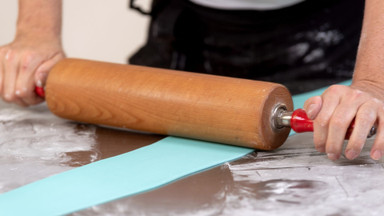Nov 20th 2020
Tips and Tricks for Rolling Fondant
Fondant is a versatile type of cake icing that one can smooth over an iced cake, creating a seamless surface. Cake designers can cut and form fondant into additional decorations, from roses to ribbons, stars, and hearts. These tips and tricks for rolling fondant should help you achieve the results you want.
Prepare Your Surface and Your Hands
Making fondant is easy, but it can be labor-intensive. Mixers can blend the ingredients, but they can’t achieve the smoothness and consistency necessary for an elegant fondant. Hand-kneading is the best way to get the texture you want.
Make sure your fondant is at room temperature before you knead it. Remove all jewelry. Make sure you have a clean, smooth, and level surface. Stainless steel, marble, or granite countertops work well, as do silicone mats or parchment paper.
Fondant gathers dust and lint easily, so make sure you are wearing a clean, lint-free apron or smock and that there are no stray threads that could attach themselves to your fondant as you work it. Take a small ball of fondant (which you will later discard) and roll it all over the work surface to pick up any remaining dust or lint.
Fondant is sensitive to temperature and humidity. Dust your work surface with cornstarch or confectioner’s sugar, or give it a thin coat of vegetable shortening.
If the consistency is sticky as you knead, you can use a little powdered sugar or cornstarch. In high humidity, cornstarch works better and keeps the fondant from becoming too damp.
Rolling Fondant
Use a non-stick rolling pin, or dust your rolling pin with a very light coating of confectioners sugar. The rolled surface will be the outside of the cake, so you want to keep it as clean and free of additives as possible.
Never turn fondant over when rolling it—simply lift and rotate it 45 degrees to roll evenly. Fondant should be about 1/8 inch thick. It is susceptible to tearing and cracking, so it’s important to use even pressure and not go too fast. You can usually repair tears by wetting your finger with a little water and sealing the edges together, or you can do the same with a bit of vegetable shortening.
Roll your fondant until you have enough to cover your cake and leave about two extra inches around it. Your cake should have a hardened layer of buttercream on it before you cover it with fondant. Fondant is heavy and doesn’t work well on light, fluffy cakes like angel food. Use it on a denser type of cake.
To lift the fondant, roll it around your pin from the far side toward you and then carefully unroll it over your cake. Smooth it quickly with your hands to prevent tearing, and trim excess right away.
A dough sheeter machine takes the labor and guesswork out of rolling fondant. You’ll get a consistent thickness and a smooth surface. Some versions will also cut the fondant into strips of your desired width or length.
Working with fondant takes practice, but a dough sheeter will get you up to speed more quickly than trial and error by hand.

